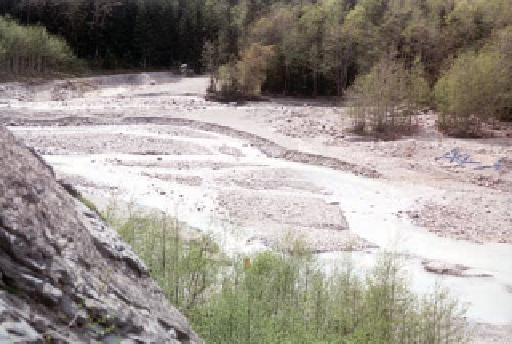Geology Reference
In-Depth Information
characterized as continental, transitional, and marine
(see Figure 6.17). Deposits of rivers and streams are found
mostly in the first two of these settings; however, much
of the detrital sediment found on continental margins is
derived from the land and transported to the oceans by
running water.
◗
Figure 12.9
Braided Streams and Their Deposits
Meandering Channels
A
braided stream
has an intricate network of dividing
and rejoining channels separated from one another by
sand and gravel bars (
Figure 12.9). Seen from above,
the channels resemble the complex strands of a braid.
Braided channels develop when the sediment supply
exceeds the transport capacity of running water, result-
ing in the deposition of sand and gravel bars. During
high-water stages, the bars are submerged, but when the
water is low, they are exposed and divide a single channel
into multiple channels. Braided streams have broad, shal-
low channels and are characterized as bed-load transport
streams because they transport and deposit mostly sand
and gravel.
Braided channels are common in arid and semiarid
regions with sparse vegetation and surface materials that are
easily eroded. So much sediment is released from melting
glaciers that rivers and streams discharging from them are
also commonly braided (see Chapter 14).
Meandering streams
have a single sinuous channel with
broadly looping curves known as
meanders
(
◗
Figure 12.10).
Channels of meandering streams are semicircular in cross
section along straight reaches, but markedly asymmetric at
meanders, where they vary from shallow to deep across the
meander. The deeper side of the channel is known as the
cut
bank
because greater velocity and fl uid turbulence erode it.
In contrast, fl ow velocity is at a minimum on the opposite
bank, which slopes gently into the channel. As a result of
this unequal distribution of fl ow velocity across meanders,
the cut bank erodes and a
point bar
is deposited on the
gently sloping inner bank. (
◗
A braided stream in Denali National Park, Alaska.
a
Figure 12.11).
Meanders commonly become so sinuous that the thin
neck of land between adjacent ones is cut off during a fl ood.
Many of the fl oors of valleys with meandering channels are
marked by crescent-shaped
oxbow lakes,
which are sim-
ply cutoff meanders (
◗
Figures 12.10 and 12.12). Oxbow
lakes may persist for a long time, but they eventually fill
with organic matter and fi ne-grained sediments carried by
fl oods.
◗
This small braided stream is near Grindelwald, Switzerland. The
deposits of both streams are mostly sand and gravel.
b
Channels periodically receive more water than they can
accommodate, so they overflow their banks and spread
across adjacent low-lying, relatively flat
floodplains
(Figure 12.10). Floodplain sediments might be sand
and gravel that accumulated when meandering streams
deposited a succession of point bars as they migrated
laterally (
Figure 12.13a). More commonly, however,
fine-grained sediments, mostly mud, are dominant on
floodplains. During a flood, a stream overtops its banks
and water pours onto the floodplain, but as it does so, its
◗




Search WWH ::

Custom Search